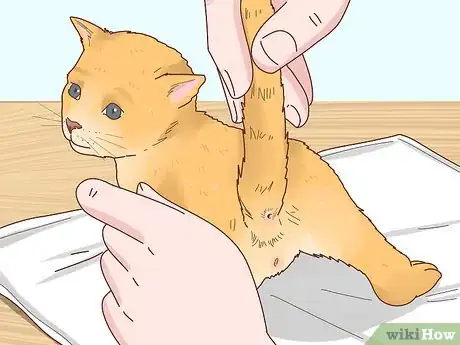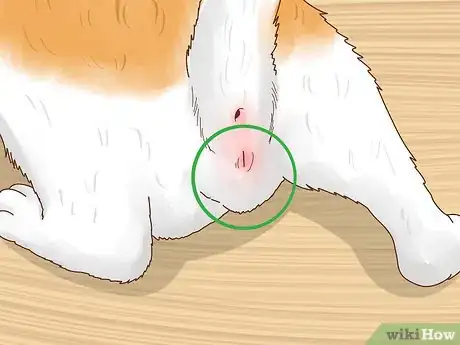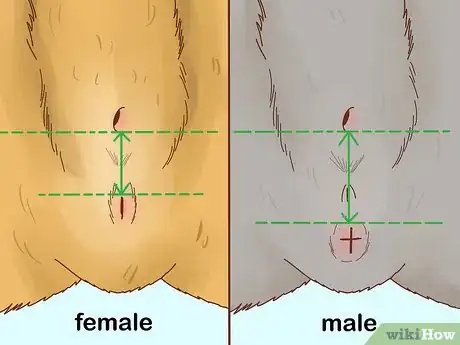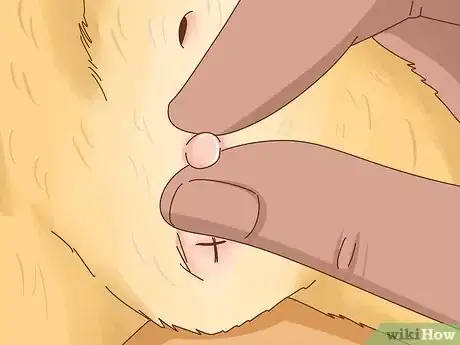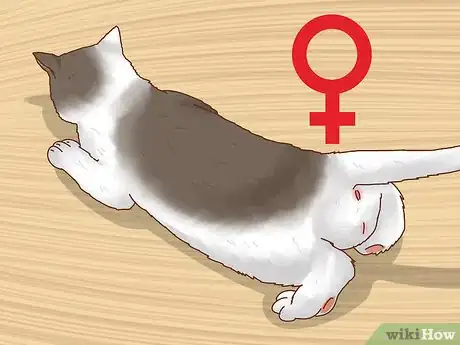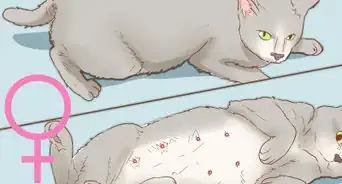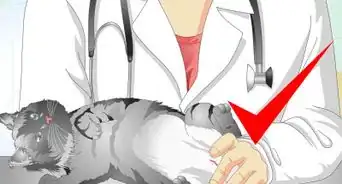This article was co-authored by Pippa Elliott, MRCVS. Dr. Elliott, BVMS, MRCVS is a veterinarian with over 30 years of experience in veterinary surgery and companion animal practice. She graduated from the University of Glasgow in 1987 with a degree in veterinary medicine and surgery. She has worked at the same animal clinic in her hometown for over 20 years.
wikiHow marks an article as reader-approved once it receives enough positive feedback. This article received 42 testimonials and 86% of readers who voted found it helpful, earning it our reader-approved status.
This article has been viewed 1,783,766 times.
Unsure if you have a boy or girl kitten on your hands? The visible differences between young male and female genitalia can be more subtle than in adults. But when you know what to look for, sexing a kitten doesn't have to be difficult. A vet's opinion can help you feel more certain, though even veterinarians can occasionally mistake the sex of a kitten.
Steps
Judging Genital Features
-
1Make sure the kitten is in a warm, safe environment. Though it may not be obvious, young kittens are very vulnerable to the cold. Until they're able to warm themselves on their own, they rely on the mother's body heat for warmth. Separating a kitten from its mother can damage its health. To avoid adversely affecting the kitten or its health, follow these guidelines when handling the kitten and trying to determine its sex:
- Handle the kittens in a warm, indoor area
- Don't separate young kittens from their mother for more than 5-10 minutes
- Don't lay kittens on "heat-sucking" surfaces like marble countertops and hardwood floors that will draw warmth out of their bodies
-
2Gently lift the kitten's tail. Checking the kitten's genitals is the most direct way to determine its sex. A kitten may be (understandably) reluctant to let you lift its tail and expose its genitals. Always be gentle. Handling a kitten roughly or using forceful motions can cause pain and may cause the kitten to lash out in self-defense. Avoid holding the kitten by its tail, which is very fragile.
- Calmly pet the kitten for a few minutes before laying it gently on a soft, clean towel and lifting its tail. Be willing to back off and return it to its mother if it shows resistance.
- Position the kitten in a standing position with its head directed away from you.
- Lift--don't tug or pull--the tail.
- If the kitten is reluctant to let you inspect beneath its tail, try getting a partner to help. The partner can gently hold the kitten in their arms while you gently lift the tail.
- You can also try to get the kitten to voluntarily lift its tail by scratching where the back meets the tail.[1]
- The kitten should have two openings. The top opening is the anus, while the bottom opening is the male or female genitalia.
Advertisement -
3Check the shape of the lower opening. If you have more than one kitten, you might compare the two side-by-side. It can be easier to distinguish males from females by comparing them directly.
- A female kitten's genital opening will look like a small vertical slit. Together, the anus and genital openings on a female kitten will look like a lowercase “i.”
- A male kitten's genital opening will look like a tiny circular hole. Together, the anus and genital openings on a male kitten will look like a colon ( : ).[2]
-
4Check the distance between the openings. Female kittens have a lesser anogenital distance than do males, so you can use the distance to distinguish the sexes.
- A female kitten's genital opening is placed higher up and closer to the anus.
- A male kitten's genital opening is further below the anus.
-
5Check for testicles. Testicles on young males are not always obvious but can still be detected. But don't ever forcibly manipulate the genitals. Penises can be especially delicate — attempting to forcefully extend a male cat's penis (which is normally withdrawn) can lead to lasting damage.
- Look carefully at the space between the genital opening and the anus. If you see a small bulge or pouch, it's likely the scrotum, and thus the kitten is male.
- If you can't visually detect a scrotum, you can feel for them in kittens that are at least a month or two old. To feel for testicles, gently pinch the area between the anus and genital opening. You may feel one or two small pea-sized lumps. Be aware that very young male kittens--younger than a month or two old--may have testicles that have retreated into the inguinal canal and cannot yet be felt.
Judging Non-Genital Features
-
1Look for sex-specific coat colors. The color of a kitten's fur can give clues to its sex.
- Certain colors, like calico (large patches of black, white, and orange) and tortoiseshell (marbled black, orange/brown, and sometimes white), are carried on the X chromosome and require two X chromosomes to appear. Thus, because females have two X chromosomes while male cats have only one, males cannot have these colors except in the case of a rare genetic disorder.
- Orange tabby (striped) cats are more likely to be male.
-
2Look for signs of a heat cycle (estrus). After about 6-10 months (and for some breeds as early as 4), most unspayed female kittens will begin to show signs of being “in heat” (scientifically referred to as being “in estrus”). A female cat may be in heat for between 2-19 days. The average cycle for a female cat that does not mate is about 8 days, but the cycle is often shorter for cats that do mate, as mating induces ovulation.[3] A cat in heat will display certain telling behaviors, which, if they occur, may indicate the cat is female. These include:
- Beginning to meow more loudly, harshly, and frequently. It will grow in intensity over time and may begin to sound like howling.
- Showing a strong urge to go outdoors
- Becoming extremely affectionate, even with inanimate objects
- Showing “presenting” behavior, wherein a female cat rests on its front legs while hyper-extending the back and lifting its tail and rear end in the air.
- Spraying urine
-
3Check for strong-smelling urine. When an unneutered male (tom) cat becomes sexually mature, he'll often develop a habit of spraying strong-smelling urine.
- A male cat may begin to spray outside the litter box, even if he's normally well-trained.
- The urine will have a strong, unmistakable smell that most find unpleasant.
-
4Evaluate the kitten's build and facial features. You likely won't be able to distinguish noticeable differences in physical features until a cat is sexually mature. Once the cat is mature enough, though, there are particular features you can look for.
- An unneutered male will tend to be lean and muscular, with thicker bones in the skull and jaw.
- Unneutered males also commonly have what's called a “stud tail.” A set of glands at the base of the tail secretes an excessive amount of an oily substance called sebum. This secretion can have telling effects on the area near the base of the tail, including greasy or matted hair; absent, thin, or patchy hair; blackheads; a rash or skin infection; and/or a foul smell.
Expert Q&A
-
QuestionAt what age should a tom cat be neutered?
 Pippa Elliott, MRCVSDr. Elliott, BVMS, MRCVS is a veterinarian with over 30 years of experience in veterinary surgery and companion animal practice. She graduated from the University of Glasgow in 1987 with a degree in veterinary medicine and surgery. She has worked at the same animal clinic in her hometown for over 20 years.
Pippa Elliott, MRCVSDr. Elliott, BVMS, MRCVS is a veterinarian with over 30 years of experience in veterinary surgery and companion animal practice. She graduated from the University of Glasgow in 1987 with a degree in veterinary medicine and surgery. She has worked at the same animal clinic in her hometown for over 20 years.
Veterinarian An average age for neutering a male cat is six months. However, it can be done earlier (such as rescue cats) from around 12 weeks of age. A mature adult male can still be neutered, but he's more likely to have established bad habits, such as spraying or fighting.
An average age for neutering a male cat is six months. However, it can be done earlier (such as rescue cats) from around 12 weeks of age. A mature adult male can still be neutered, but he's more likely to have established bad habits, such as spraying or fighting. -
QuestionWhat is the right age to neuter kittens?
 Pippa Elliott, MRCVSDr. Elliott, BVMS, MRCVS is a veterinarian with over 30 years of experience in veterinary surgery and companion animal practice. She graduated from the University of Glasgow in 1987 with a degree in veterinary medicine and surgery. She has worked at the same animal clinic in her hometown for over 20 years.
Pippa Elliott, MRCVSDr. Elliott, BVMS, MRCVS is a veterinarian with over 30 years of experience in veterinary surgery and companion animal practice. She graduated from the University of Glasgow in 1987 with a degree in veterinary medicine and surgery. She has worked at the same animal clinic in her hometown for over 20 years.
Veterinarian Traditionally kittens were neutered at around six months of age, since this is when they are able to father kittens or fall pregnant; however, there is a growing movement to start neutering at an earlier age, even as young as 10 weeks. Scientific studies have shown surgery at this age is safe and is not associated with complications in the long-term. The best person to discuss what is right for you cats, is your vet.
Traditionally kittens were neutered at around six months of age, since this is when they are able to father kittens or fall pregnant; however, there is a growing movement to start neutering at an earlier age, even as young as 10 weeks. Scientific studies have shown surgery at this age is safe and is not associated with complications in the long-term. The best person to discuss what is right for you cats, is your vet. -
QuestionHow do I tell the sex of a newborn kitten?
 Pippa Elliott, MRCVSDr. Elliott, BVMS, MRCVS is a veterinarian with over 30 years of experience in veterinary surgery and companion animal practice. She graduated from the University of Glasgow in 1987 with a degree in veterinary medicine and surgery. She has worked at the same animal clinic in her hometown for over 20 years.
Pippa Elliott, MRCVSDr. Elliott, BVMS, MRCVS is a veterinarian with over 30 years of experience in veterinary surgery and companion animal practice. She graduated from the University of Glasgow in 1987 with a degree in veterinary medicine and surgery. She has worked at the same animal clinic in her hometown for over 20 years.
Veterinarian Look under the newborn's tail. Check the spacing between the anus (directly under the tail) and the vulva or penis. In the female, the vulva is just a few millimeters from the anus; in the male, the penis is lower down, almost between the back legs. In addition, there may be two tiny bumps (the testicles), between the anus and the penis in the male. However, these differences can be tricky to spot, and it really helps to compare one kitten with another, if there are several in a litter.
Look under the newborn's tail. Check the spacing between the anus (directly under the tail) and the vulva or penis. In the female, the vulva is just a few millimeters from the anus; in the male, the penis is lower down, almost between the back legs. In addition, there may be two tiny bumps (the testicles), between the anus and the penis in the male. However, these differences can be tricky to spot, and it really helps to compare one kitten with another, if there are several in a litter.
Warnings
- Avoid handling kittens less than three or four weeks old. Kittens less than three to four weeks old can absorb too much of your human scent, making it difficult for the mother to recognize them. If that happens, the mother may reject the kitten, which can lead to its death from lack of warmth and nutrition.[4]⧼thumbs_response⧽
- Just as the kittens may be reluctant to allow you to handle them, a kitten's mother may become agitated and defensive if she senses that her kitten is in danger. Always be sure the mother is comfortable with you handling her kitten before you grab it. If at any point the mother becomes angry or distressed, stop and return the kitten to her.⧼thumbs_response⧽
References
- ↑ http://www.petmd.com/cat/centers/kitten/health/evr_ct_determining_sex_of_cat
- ↑ http://cats.lovetoknow.com/caring-kittens/how-determine-sex-kitten
- ↑ Johnston, Shirley D. et al Canine and Feline Theriogenology Philadelphia: W.B. Saunders, 2001
- ↑ http://www.pet-informed-veterinary-advice-online.com/sexing-kittens.html
About This Article
Before you try to determine the sex of a kitten, make sure you're in a warm, indoor area and that you won't be separating the kitten from its mother for longer than 5-10 minutes. When you're ready to get started, place the kitten on a soft, clean towel and position it so it's standing with its head facing away from you. Then, gently lift up the kitten's tail so you can see its genitals. If the genital opening looks like a small, vertical slit, it's a female kitten. If the opening looks like a tiny, circular hole, it's a male kitten. To learn how to determine the sex of a kitten by looking at its other physical features, scroll down!

